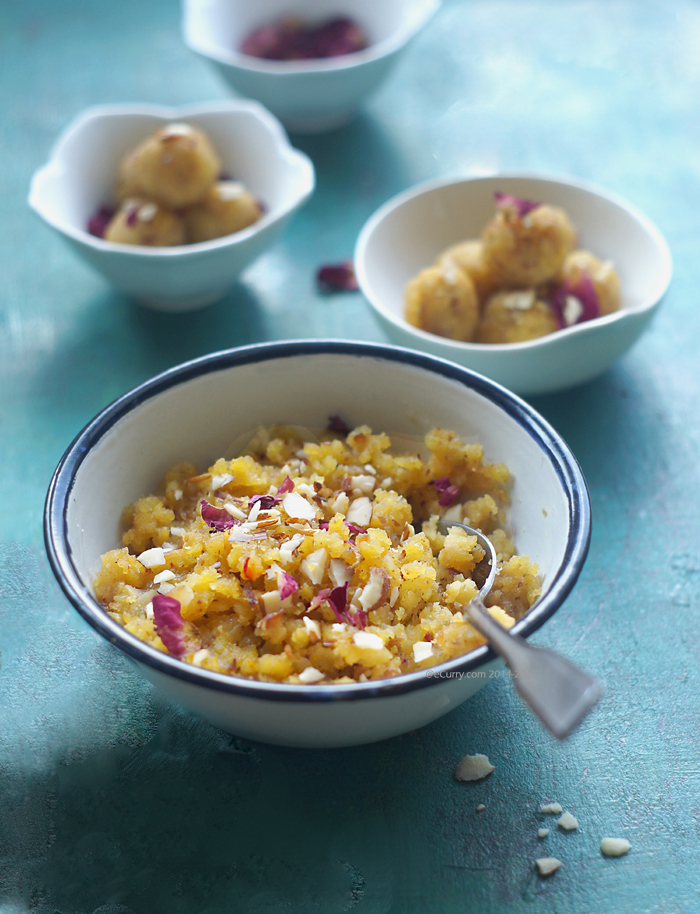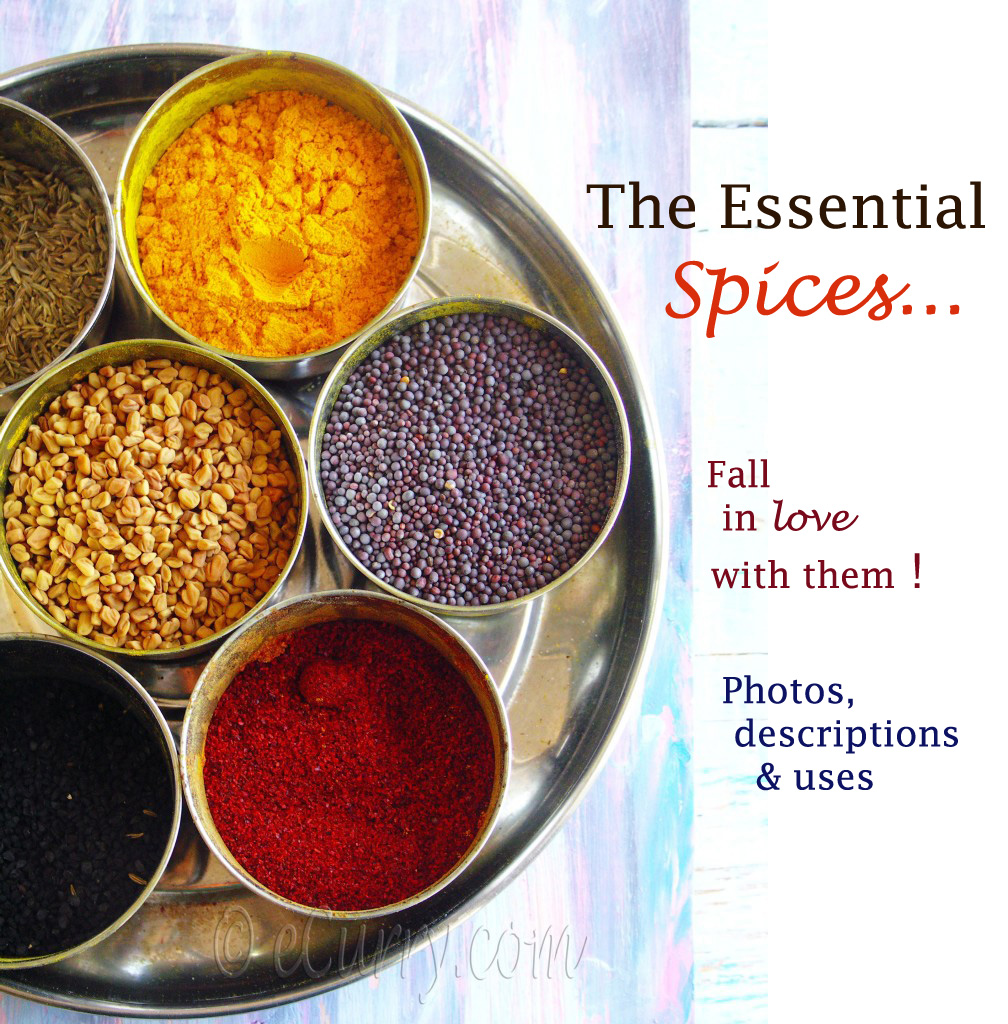
Moong Dal or the husked yellow Moong Halwa is a popular confection in the northern and north western regions of India. This is made usually during the winter months. The lentils are slowly cooked in ghee releasing its rich, nutty aroma. It is sweet and redolent of cardamom and saffron.
The biggest festival in India, Diwali just went by. According to some Indian calendars, we have stepped into another new year. From one year to another, from one day to the next, we move ahead; marked by days that evoke intense nostalgia and at the same time paving paths for more to look back to in the future days.

It is for a reason that India is called the country of diversity. Each state is proud of its own language, food, costume and culture.

While most parts iof India start the preparations for Diwali a month ahead, we start to slow down in West Bengal around the approach of Diwali. Our biggest religious festival – the Durga pooja, comes to an end. The Lakshmi Pooja, or the worship of goddess Lakshmi is over too. There is a certain kind of quiet and mood of tearful farewell instead of festivities. The goddess Durga is immersed, the lights and decorations have been taken down. All of it end as suddenly as it arrives. leaving us with a tinge of gloom, along with the hope of the celebrations next year.

While the rest of the country is gripped by the Diwali fervor, the Bengalis worship Goddess Kali on this day, symbolic of Shakti or power and strength overcoming the evil and bringing in good. The day is typically unhastened. We are not pressed for time to cook a myriad dishes. We slowly gather candles and Deeps, the little earthen lamps – to be filled with mustard oil where the wicks soaks. I would wait for Baba to get the firecrackers a few days ahead. Not the noisy ones. Just the sparklers and a few more. ( I have to admit here that I had been scared of these for the longest time in my life! ). Then I would carry them up on the terrace and have them toast in the sun. They crackle and sparkle better being warm.

On the day of the Choti Diwali, which is Kali Pooja for us, we decorate our homes with candles and deeps – glowing, shimmering, burning down the evil on this dark no moon night. This is the first part of the day: setting up the lights all around the house, the walkways, on the edge of the terrace railings, window sills and verandah. We never had electric lights trimmming our homes. There is a different charm in this process of spending time to prepare the earthen lights and setting them up. Then the warm flickering glow, casting shadows and lights of hope. There is no such warmth in convenience of the modern day bulbs.

A’s home in Jaipur this Diwali. Decorated by his niece Damini.
There never was a frenzy of preparation for food like the rest of the country. Most adults fast until the worhip hour is over, which is often late at night. We would have a few homemade snacks and sweets for the time we burned our fire crackers, or if someone happened to visit. And we would have a good hearty Khichuri for our meals.
All of our cousins (which happened to be all girls), gathered on the “rock” , the red porch running from one end of our :”purono bari” (old home) to the other end which merged with the street. The fire crackers would be piled on the small red step and some inside the house just by the black collapsible gate. We would line up and then start the ritual of burning the crackers and ocassionally running inside closing our ears when some boys would be nasty enough to plant a “bomb” or a loud cracker right infront of our home, just to scare us. Being a “girl team” we never really got fascinated with these loud noisy crackers.

Halwa in making: (Follow from left )
Step 1(first photo on the left): Cook lentils in ghee.
Step 2: until it reaches a crumbly texture as in the second photo. Stir constantly.
Step 3: Add saffron, cardamom and milk and cook until the lentils are cooked through
Step 4: Add sugar solution until the right consistency is reached.
(detailed recipe below)
Once we got done with this, with the smoke and the smell hanging in the air, we would quietly go in and hang around together, waiting for the time when we would go for the worship. Late at night. The wax from the candles would have melted, pooled and dripped down the railings of the verandah. The diyas would have dimmed. Some had just the faint glow in the wick with the ashes accumulated once where there was fire. The air still heavy with loud noises, smoke and a smell which belonged only on the Diwali night.

That was pretty much my Diwali. We followed a similar routine for years. For as long as I remember.
However even if the regions Diwali is one of the biggest festivals, the traditions differ from one region to another. In most places the goddess Lakshmi is worshipped for prosperity and health. The house is cleaned and painted, new costumes are bought, and the kitchen of the home is a glowing hearth cooking up all kinds of sweet and savory snacks.

Yellow Moong: Split Yellow Lentils
Married to the man to belongs to the western regions of India, the meaning of Diwali has a whole new vibration to it. Unfortunately I have never had a chance to celebrate Diwali together with his family in this past 20 years. The man himself is not big into celebrations. So we do not “party” at home or anywhere else for the ocassion. Instead we quietly light our diyas and candles, say a prayer and cook whatever little we can.

This time I made this Moong Dal Halwa and some Kachoris (will post soon).
Moong Dal Halwa: Yellow Moong Halwa
Ingredients: (Serves 6-8 in small dessert portions)
- 3/4 cup yellow moong dal/lentils
- 1/4 cup ghee (use butter substiute for vegan version)
- 1 cup milk (use almond milk to make a vegan version)
- 1/2 cup sugar (adjust to taste)
- a generous pinch of very good quality saffron
- 7 small green cardamom pods, shelled (powder the black seeds)
- 1/4 cup almond powder/flour (or khoya/thickened milk: available in Indian groceries)
- nuts + more nuts to garnish (almonds- blanched and sliced or flaked or pistachios or a combination of both – lightly toasted)
- a few drops of rose water + edible petals for garnish (optional)
Method:
Optional Step:In a hot dry skilet toast the yellow moong until they are intensely yellow and aromatic.Not brown. You have to keep stirring them to prevent them from getting brown spots on them. As soon as you see them turning deeper yellow, remove them from the skillet. For halwa the lentils are not usually roasted. However I love the nutty flavor of roasted moong. The step is optional. Soak them after toasting if you choose to do this step.
Soak the lentils for about 4-5 hours. Wash and drain the water and coarsely grind it (not paste). If you had needed to add water during processing the dal/lentil, try to sieve out as much water as you can by draining on a muslin cloth. This wll quicken your cooking process.
Heat ghee in a pan, preferable a pan with thick bottom and non-stick coating. Add the coarsely processed dal/lentil and cook while stirring almost continuously on a low flame until the lentil starts to dry out. It will slowly start to look like crumbs and the color will be golden light brown. This will take anywhere between 15-25 minutes. Do not cook at high heat. You cannot fasten this process.
While the dal/lentil cooks, heat the milk in a different pan or in the microwave, and add the saffron. Allow the saffron to soak in hot milk until you are ready to use. Bring 3/4 cup of water to a boil. Add the sugar and cook until the sugar completely dissolves. Reduce the heat and cook for another 7-10 minutes. The solution will thicken a little. Set aside.
Once the lentils in the pan have dried and reached the golden hue, add the milk with the saffron, cardamom powder, the nuts and almond powder (if you are using khoya you will add the khoya at the end). Cook at low flame, partially covered until all the liquid is absorbed. Keep stirring frequently to prevent burning at the bottom of the pan. This will take another 30 minutes or more. The lentils should be fully cooked during this step. Once the lentils seems cooked and the raw taste is gone, uncover and cook and stir. You will slowly see the lentils will start to glisten. The fat is released when the lentils are cooked. You will see the ghee glistening on the pan too. Now it is ready for the sugar solution to be added.
Add the sugar solution: cook and stir until you get the desired consistency. By the time you are done, it should have dried up to a scooplable or droppable consistency. The ghee will be glistening on the pan and on the halwa. The mix should be still moist. If you are using khoya, add it now and cook for a while until the khoya has melted and combined well the lentil mix.
You can make it slightly more dry, if you want to roll them in balls. If you want to roll them in balls like truffles, the consistency should be such that if you take a scoop in your palms, close your fist and open it, it should hold the shape. You will need to do this while the halwa is still warm.
Finally if you are using rose water, add it when the halwa cools down to room temperature and toss well to combine.
Halwa is usually served warm. If not serving right away, it has to be refrigerated and then it can be warmed up before serving. Garnish with more nuts and rose if you wish.
Preparation Time: 10 minutes
Cooking Time: 2 hours
Difficulty Level: Intermediate
Serves: 6-8

Related Posts:
- Anjeer/Fig Halwa
- Badam Katli/Almond Fudge
- Beetroot Halwa
- Besan ki Burfi – A Chickpea Fudge?
- Churma and Churma ke Laddoo
- Gajar ka Halwa (Carrot Halwa)
- Gujia: Pastry filled with Coconut, Dry Fruits & Nuts
- Semolina and Almond Halwa












This looks absolutely decadent, Soma 🙂
Sensational pics!
Soma … ami na kokhono milk diye korini. Texture ta alada hobe nischoi. Next time kore dekhbo. Laddoo gulo ki cute lagche. Er por banale oi laddoo baniye tarpor khabo. 🙂
I never had mung daal halwa, have to make it soon.
Awesome traditional recipe. The images are so tempting. 🙂 thanks for sharing 🙂